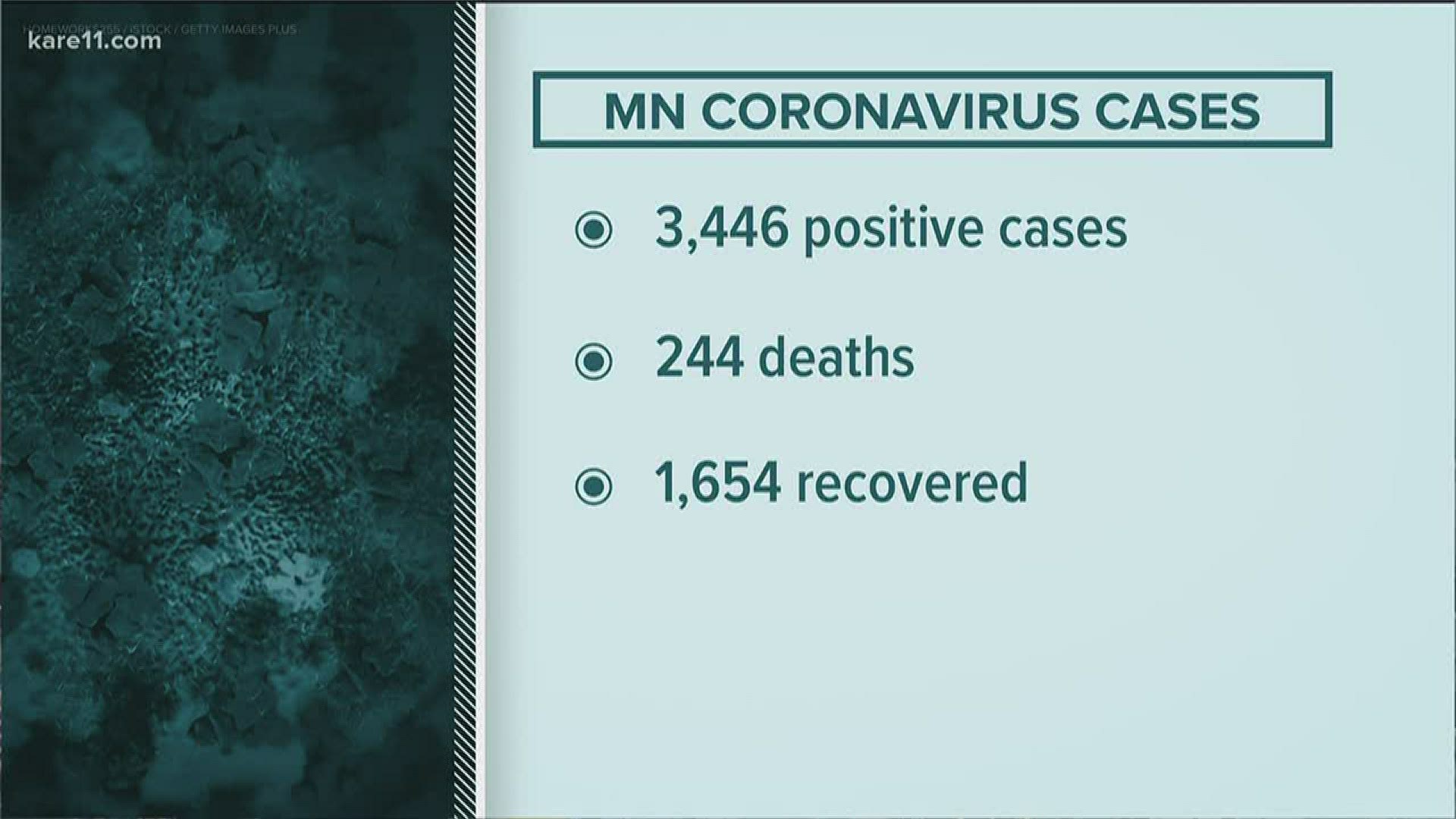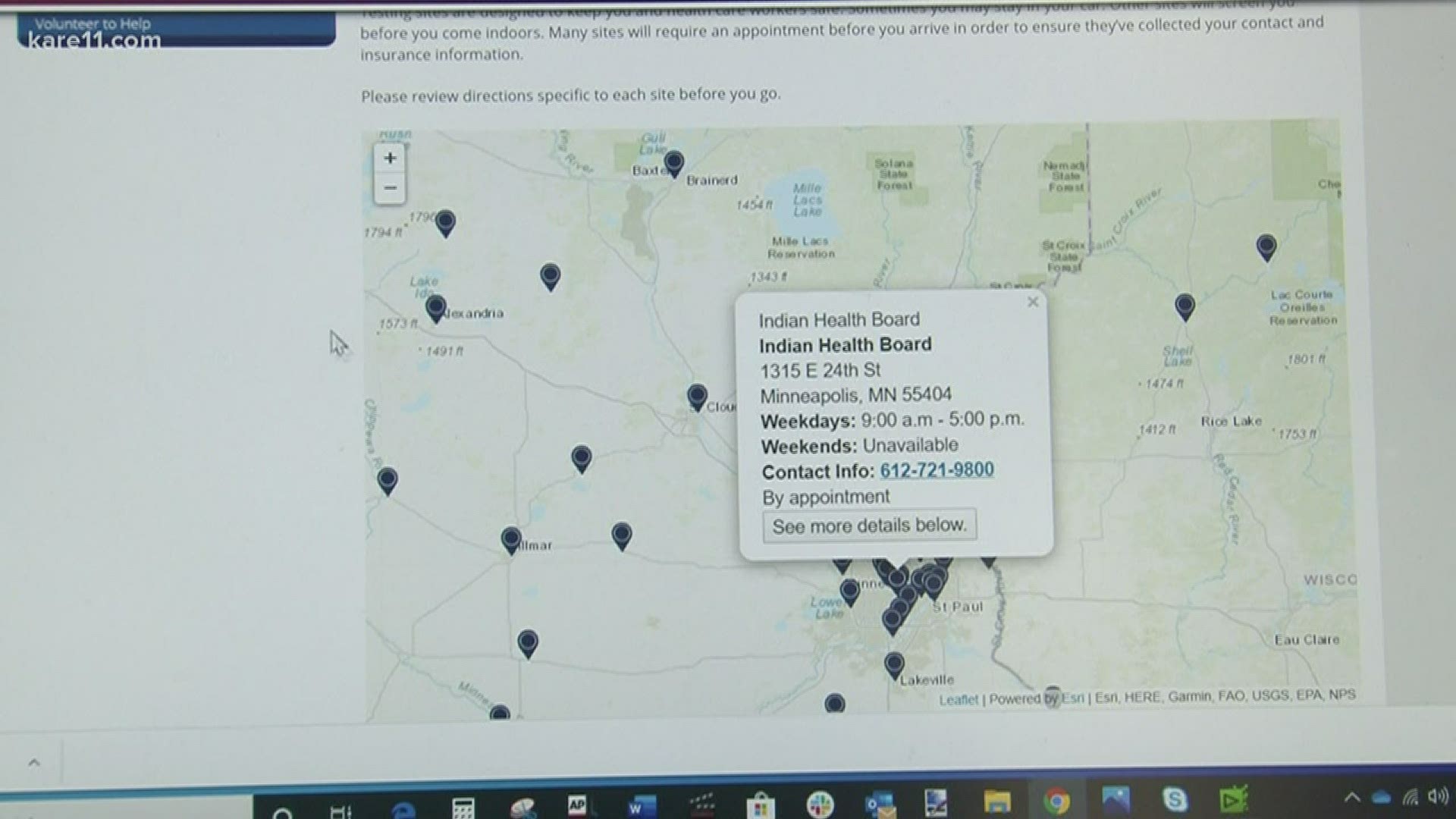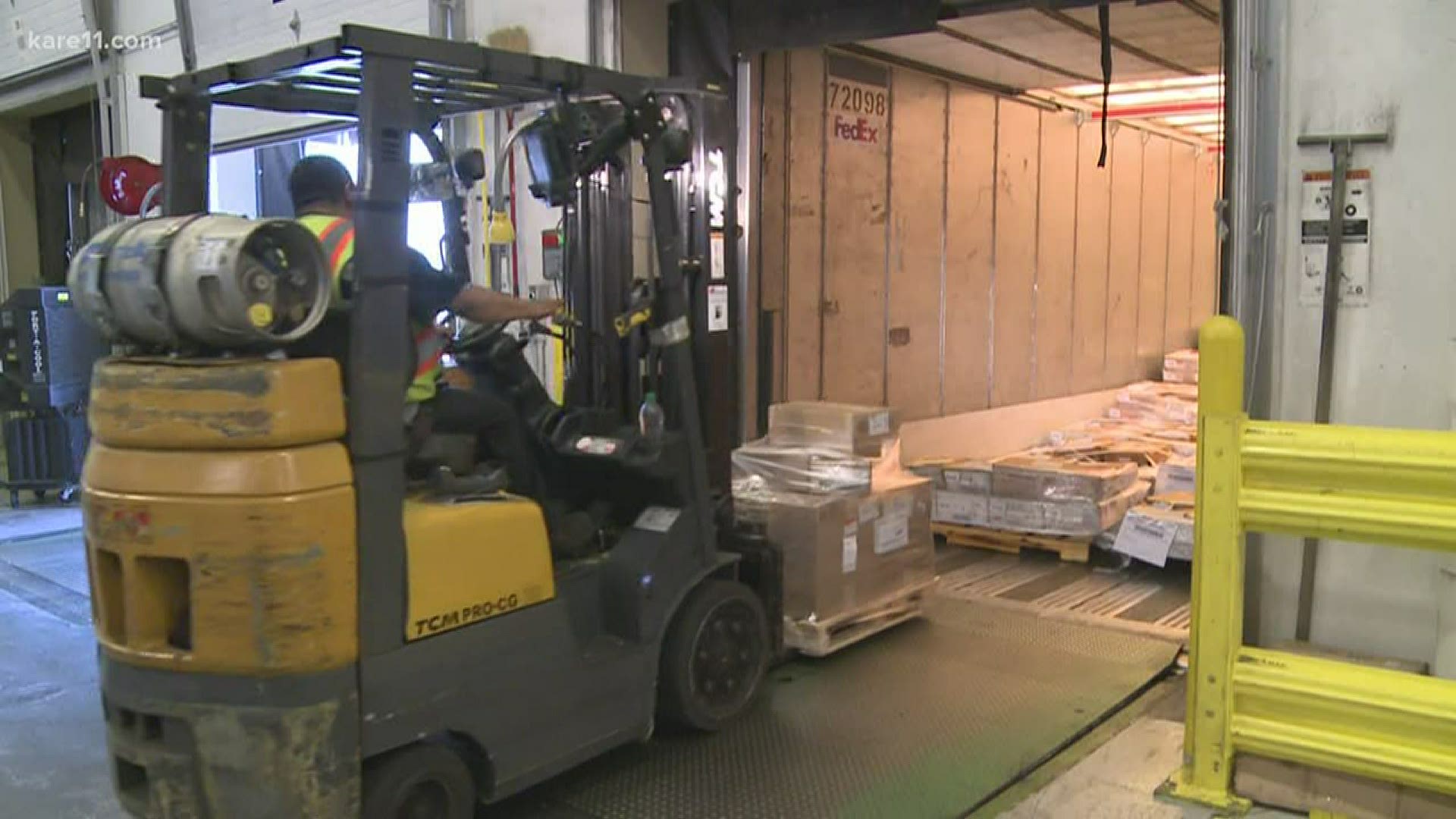ST PAUL, Minn. — Sunday, April 26
2:30 p.m.
The Wisconsin Department of Health Services Announced Sunday that the total number of positive coronavirus (COVID-19) cases in the state had risen to 5,911 with 272 deaths.
Officials say 2,669 people have recovered from the coronavirus in Wisconsin.
Cases are relatively evenly split between men (48%) and women (52%).
You can find more information at Wisconsin Department of Health Services' website.
11 a.m.
The Minnesota Department of Health (MDH) says as of Sunday, 3,602 people across the state have tested positive for COVID-19, and 272 people have died of complications from the virus.
That's an increase of 156 cases and 28 additional deaths.
Health officials say the counties of residence of these new cases are as followed: Hennepin (45), Nobles (27), Ramsey (17), Olmsted (1), Clay (13), Dakota (5), Anoka (13), Blue Earth (2), Carlton (4), Carver (1), Kandiyohi (7), Martin (1), Meeker (2), Pine (7), Polk (3), St. Louis (2), Sherburne (1), Watonwan (2), Washington (1), and two cases are missing county of residence.
MDH provided the age range and county of residence for the 28 additional deaths:
- Dakota County resident in their 90s
- 6 Hennepin County residents in their 90s
- 7 Hennepin County residents in their 80s
- 4 Hennepin County residents in their 70s
- 3 Hennepin County residents in their 60s
- Hennepin County resident in their 50s
- Hennepin County resident in their 40s
- Washington County resident in their 50s
- 2 Anoka County residents in their 80s
- Clay County resident in their 90s
- Clay County resident in their 80s
Health officials say five fatalities were not long term care residents: two individuals in Hennepin County in their 70s, an individual in Clay County in their 90s, an individual in Washington County and an individual in Dakota County.
MDH officials say 829 of those cases in total have required hospitalization, and 285 are still hospitalized. The amount of patients in intensive care is now at 115.
Official say 1,774 patients no longer need isolation.
“We express our condolences to the families and friends of those who died,” Minnesota Commissioner of Health Jan Malcolm said in Sunday's news release. “We continue our work along with many partners around the state to protect Minnesotans and prevent additional deaths. It is very important for all Minnesotans to do their part in that effort by following social distancing guidelines and other public health recommendations.”
Saturday, April 25
2 p.m.
The Wisconsin Department of Health Services is reporting 331 new COVID-19 cases for a total of 5,687, with 266 deaths, as of Saturday.
Roughly 1,376 (24%) of those testing positive have required hospitalization.
Cases are relatively evenly split between men (48%) and women (52%), however men make up 59% of all deaths reported, while women make up 41% according to WDHS.
Wisconsin counties with the most cases are Milwaukee, Brown, Dane, and Kenosha with 2,525, 720, 401 and 329 positive COVID-19 cases respectively.
Milwuakee and Dane comprise the most deaths in the state, with 157 and 21 deaths respectively.
You can find a more granular break down of cases across Wisconsin on the Wisconsin Department of Health Services' website.
11 a.m.
The Minnesota Department of Health (MDH) says as of Saturday, 3,446 people across the state have tested positive for COVID-19, and 244 people have died of complications from the virus.
That's an increase of 261 cases and 23 additional deaths.
MDH says 797 of those cases in total have required hospitalization, and 288 are still hospitalized. The amount of patients in intensive care has dropped from 111 on Friday to 109 on Saturday. There are 1,654 patients of the total who no longer need to be isolated.
Hennepin County has the most cases in the state by far at 1,287, with 155 deaths. Nobles County jumped from 258 cases Friday to 325 on Saturday, surpassing Ramsey County for the second-most in the state. Ramsey County has reported 261 cases and 20 deaths as of Saturday, and Olmsted County has 238 cases and six deaths.
MDH has been prioritizing testing for people in congregate care, hospitalized patients and health care workers, which may impact the scale of those numbers. However, on Wednesday they announced that they are now advising providers to test as many symptomatic patients as they can.
Researchers at the University of Minnesota believe for every one Minnesotan who tests positive for COVID-19, there could be 100 who have undetected cases of the virus.
At this point in the pandemic approximately 56,597 Minnesotans have been tested by MDH or an outside lab. That means 2,810 tests were administered in the last 24-hour round, up from 2,239 in the previous one.
Friday, April 24
2 p.m.
Gov. Tim Walz addressed Minnesotans on his daily update call with health and emergency officials on Friday, saying that the state is starting to "climb that curve" with regard to COVID-19.
The Minnesota Department of Health (MDH) reported 21 additional deaths and 243 new confirmed cases on Friday. Walz and the MDH, along with the University of Minnesota and the Mayo Clinic, announced a plan this week to ramp up testing numbers to 20,000 diagnostic and 15,000 antibody tests per day.
Walz has said more testing will result in the numbers of confirmed cases going up even more rapidly, but also acknowledged that COVID-19 is spreading out across the state. He announced Friday that the state has created a website where people can find testing locations in their community, and view their test results when they are ready.
The governor said that truly making testing available in every community for every symptomatic person could take weeks, but he believes anyone who wakes up with symptoms should soon be able to find a nearby testing location.
"They don't need to be driving 100 miles, and they don't need to be (hearing), 'No you can't get a test,'" Walz said.
Walz said Vice President Pence brought up what Minnesota is doing as a positive example on his latest call with U.S. governors.
The governor said that Minnesota's Department of Employment and Economic Development has now started issuing unemployment checks to self-employed workers and independent contractors who are out of work - a category that has only just been made eligible.
Friday was Walz's first public address since announcing Thursday that schools will be closed for the rest of the academic year. He called it an "incredibly hard decision."
Walz invited a group of students and teachers to join the call and talk about their experiences with distance learning - and their challenges.
"This may be one of the defining moments of our generation," said Lap Nguyen, a high school senior in Rochester. "That in the depths of separation and isolation, we are able to overcome that and grow closer together."
Glazell Toledo, a Minnesota high school math teacher, said she works with students who have extraordinary needs, and have been through extensive trauma.
"At school, we are their lives," Toledo said.
She said now, she cannot get them to engage from home. She said many of them are picking up extra shifts to help their families make ends meet, or acting as caregivers at home.
As a Filipina woman, she said, she has experienced racism during the COVID-19 pandemic, and has seen it directed at others in the Asian and Pacific Islander community.
"Please be mindful and interrupt COVID-19 racism when you see it," Toledo said.
Lt. Gov. Peggy Flanagan acknowledged that for families who do not have reliable internet or enough computers, distance learning is challenging.
She said that the pandemic has "laid bare" the inequities in our communities.
Minnesota Department of Education Commissioner Mary Cathryn Ricker said they are taking a look at what is working, and what's not.
"Distance learning has been hard on everyone, even when everyone is doing their best," she said. "School closures put burdens on students and families."
She said they know that the burden is heavier on families of color, indigenous communities, immigrants and refugees, and students with disabilities.
"We should be doing more, and we will be doing more," Ricker said. "The feedback was clear. We know distance learning hasn't been going perfectly. It's actually been really hard."
She said she's instructed her team to make some improvements:
- Recommitting to intentional relationship-building with students and families
- Working with public and private partners to get broadband access and devices into the hands of every student who does not have them
- Partnering with other organizations to bring in additional adults to check in on students' well-being, to enhance support for families
Ricker said distance learning has shone a light on the fact that schools are for more than just academic learning.
"They are places where students do more than grow academically," Ricker said. With schools closed, she said, there are fewer adults checking in on students.
"No matter what, every child deserves a world-class education," Ricker said.
Flanagan also emphasized that mental health resources are still available via telehealth for those who are struggling.
"If you are a student needing help, you are not alone. If you are a parent needing help, you are not alone," Flanagan said. "If you are a teacher needing help, you are not alone."
Flanagan said anyone can text MN to 741741 or call **CRISIS, and that mental health resources are available on the state's website.
Walz is not yet giving an answer on whether he will extend the state's Stay at Home order, right now set to expire May 4.
"I don't want to be driven by an arbitrary date or an arbitrary number, I want to see how Minnesotans are responding," Walz said.
The governor said he will look at the data and the testing, and that right now it looks like the COVID-19 peak could come in later May.
"I think you can expect sometime middle of next week that we'll be making that decision," he said.
Walz said he is "guardedly optimistic" that the state is ready for that peak, in terms of hospital supplies and capacity.
"As of today I feel confident that anyone who would need critical care in a hospital would get it," he said.
Walz said the fact that New York may be plateauing soon opens up a lot of supplies that can be used in other parts of the country. He said on Friday's call with the governors, there was "much more sense of certainty" regarding supply chain issues.
MDH Infectious Disease Director Kris Ehresmann said in addition to monitoring COVID-19 cases at the JBS pork plant in Worthington, Minnesota, they are working with "a number of facilities in different parts of the state."
11 a.m.
Minnesota Governor Tim Walz's warning that the number of reported cases of COVID-19 will likely be going up was reflected Friday, as the Minnesota Department of Health reported 21 additional deaths from complications of the virus, and 243 more positive tests.
That brings the total of fatalities to 221 since the start of the coronavirus pandemic, and total 3,185 cases of the virus. Walz's warning about the increase in numbers is linked to Minnesota's ramp-up in testing: More than 2,200 tests were performed in the last 24 hours, the highest daily total yet, but those numbers are expected to increase rapidly as well.
MDH says 278 people are hospitalized with COVID-19 across the state as of Friday, with 111 being treated in the ICU. A total of 756 people have required hospitalization since statistics started being compiled in late January.
The number of people who are recovering and no longer require isolation has increased to 1,594, more than half the number of COVID-19 cases diagnosed in Minnesota.
The gender balance of those testing positive appears to be balancing out as well. While women made up the majority of patients for a number of weeks, they now number 50 percent of them.
The greatest exposure factor is in congregate living settings, linked to 29% of cases. Community transmission with no known contact accounts for 18%, with 14% of transmissions linked to travel and 10% involving health care workers or staff.
MDH has been prioritizing testing for people in congregate care, hospitalized patients and health care workers, which may impact the scale of those numbers. However, on Wednesday they announced that they are now advising providers to test as many symptomatic patients as they can.
Thursday, April 23
4:30 p.m.
Following Gov. Tim Walz's announcement to continue distance learning through the end of the current school year, the Minnesota State High School League (MSHSL) announced that spring athletics and activities are officially canceled for the school year.
The MSHSL previously suspended competitions in March, in the midst of the winter sports tournaments, as the numbers of confirmed coronavirus cases began to rise in Minnesota and across the country.
2 p.m.
Governor Tim Walz announced distance learning will continue through the end of the academic year. He said there is no joy in making this announcement and addressed the class of 2020.
"You will not be defined by staying home and missing proms and missing graduations." Walz said. "You will be defined by understanding how interconnected our world is and what it means to come together and try and solve hard problems."
Walz also announced that around 100,000 people could potentially return to work April 27, according to a plan he is outlining. The jobs are in industrial, manufacturing and office settings.
Businesses that are reopening will need to create a safety plan, including conducting health screenings of workers. All workers who can work from home are still asked to do so if possible. Any retail or customer facing parts of the businesses will need to remain closed.
Walz said there will be many more confirmed cases due to the increased testing but he said the important measures will be to determine how many people needed to be hospitalized and what the strain would be on the health system.
Walz said the state is making progress and Minnesota has been doing well flattening the curve but that the process is going to be "a long haul."
The Stay at Home order is still set to expire May 4.
Walz said officials are actively looking at activities that can still be carried out while being safe and socially distancing.
Businesses and nonprofits will be able to work with the state to develop templates for reopening and the process will include a public comment period, Walz said.
There were 21 deaths announced today due to the virus and 20 of them were people in long-term, congregate living facilities.
Department of Employment and Economic Development Commissioner Steve Grove said Minnesota has now surpassed the number of unemployment applications submitted during the Great Recession.
Walz said he has not made a definitive call on the state fair. He added social distancing would be nearly impossible.
Thursday, April 23
11 a.m.
New numbers released by the Minnesota Department of Health (MDH) Thursday suggest that the state continues to climb the deadly developmental curve of COVID-19.
MDH says 21 Minnesotans died of complications from the coronavirus yesterday, the deadliest day since the pandemic began. That brings to 200 the total of fatalities linked to the virus, up from the 179 reported Wednesday.
Positive tests for the virus are now up to 2,942, an increase of 221 over Wednesday's 2,721. Currently 268 patients are hospitalized, with 104 being treated in the ICU. In total, 712 people have required hospitalization since the onset of COVID-19.
On the recovery front, 1,536 people who tested positive for coronavirus no longer require isolation.
MDH says a total of 51,548 Minnesotans have been tested for the virus, 2,204 in the past day. That number is the biggest since the pandemic began, and testing totals are only expected to increase going forward with Wednesday's announcement that the state has partnered with the U of M, Mayo Clinic and other state providers with the goal of testing up to 20,000 patients for coronavirus and another 15,000 for antibodies each day.
9:30 a.m.
Multiple sources are reporting that Governor Tim Walz will announce that he is keeping schools across Minnesota closed for the remainder of the academic year.
A source tells KARE 11 Walz relayed his decision during a call with legislators Thursday morning. Laura McCallum from Minnesota Public Radio, KARE 11's news partner, also says two sources confirm that the governor has made his decision and will make it public at his daily news briefing Thursday.
Minnesota students have been in "distance learning" since mid-March when Walz issued his Stay at Home order.
KARE 11’s coverage of the coronavirus is rooted in Facts, not Fear. Visit kare11.com/coronavirus for comprehensive coverage, find out what you need to know about the Midwest specifically, learn more about the symptoms, and see what companies in Minnesota are hiring. Have a question? Text it to us at 763-797-7215. And get the latest coronavirus updates sent right to your inbox every morning. Subscribe to the KARE 11 Sunrise newsletter here. Help local families in need: www.kare11.com/give11.
The state of Minnesota has set up a hotline for general questions about coronavirus at 651-201-3920 or 1-800-657-3903, available 7 a.m. to 7 p.m. There is also a data portal online at mn.gov/covid19.
More information on the coronavirus:



